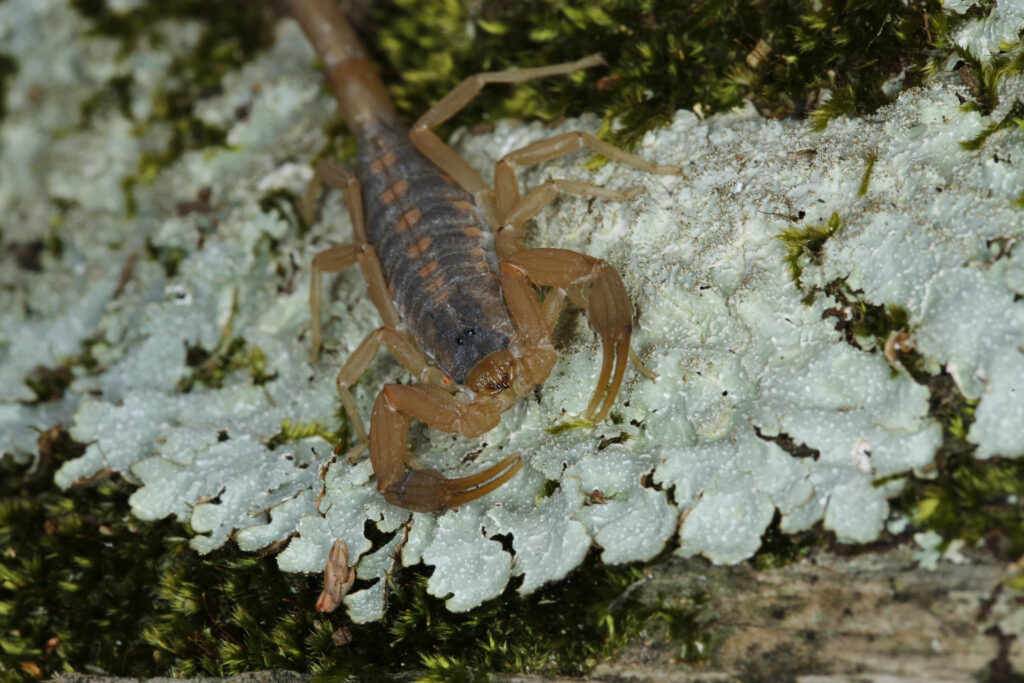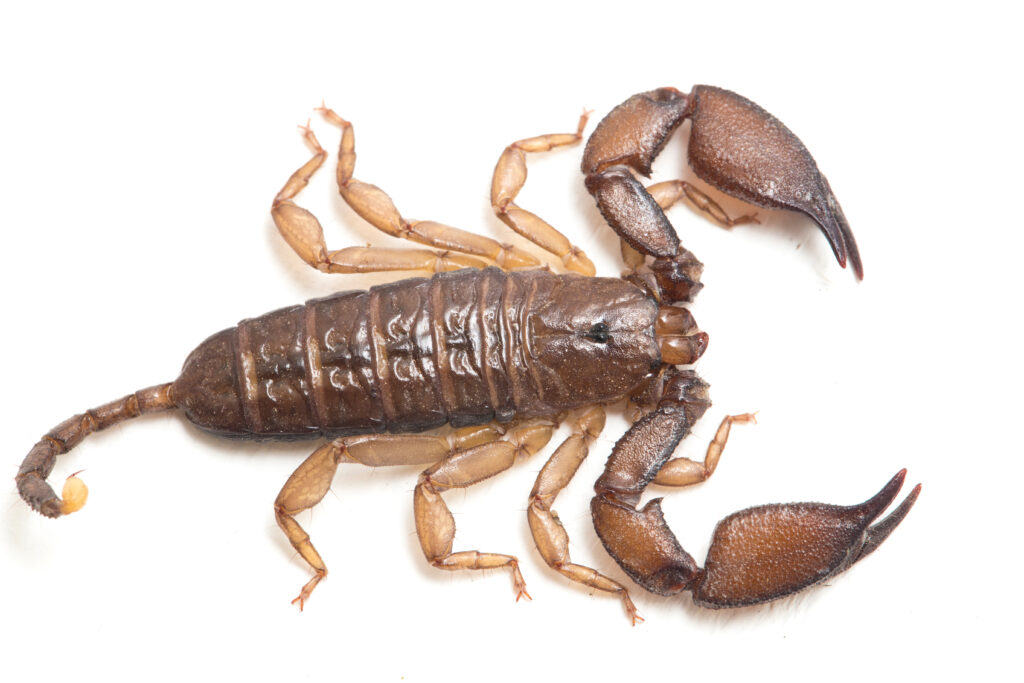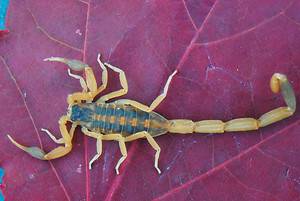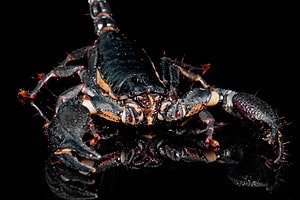Spanning an immense 268,596 square miles, Texas is the second-largest US state. Therefore, it’s not surprising that it is home to thousands of animals which are spread across its vast, diverse ecosystems. However, some of the smallest and most abundant animals in the state are scorpions. There are 18 different species of scorpions in Texas, and they can be found underneath rocks, in sand dunes, and even in your home.
Despite their size, scorpions can look quite menacing with their stingers and tails held over their back as well as the sharp-looking pincers at the front end. So, you’re probably wondering just how dangerous they really are, right? Well, let’s find out!
1. Texas Cave Scorpion (Pseudouroctonus reddelli)

Texas cave scorpions are primarily found in caves, although they can also be found in other rocky areas.
©Cathleen Wake Gorbatenko/Shutterstock.com
Ranging between 1.5 and two inches long, the Texas cave scorpion is a dark brown color and has fairly thick pincers. As their name suggests, they are primarily found in caves, although they can also be found in other rocky areas, particularly where there is plenty of dense limestones. Texas cave scorpions primarily prey on a range of insects and spiders. However, they prefer to eat cave crickets which are widely found across the habitat of these scorpions. Although they can sting, Texas cave scorpions are not particularly dangerous. Their sting is described as being similar to that of a bee.
2. Eastern Sand Scorpion (Paruroctonus utahensis)
The eastern sand scorpion lives in sandy habitats across Texas, New Mexico, Arizona, and Utah. They are a pale yellow color which means they blend in well with their environment, particularly when they burrow into the soil at the base of plants. They are between one and three inches long and mainly eat small insects. Again, their sting is a little worse than that of a bee sting.
3. Russell’s Scorpion (Chihuahuanus russelli)
A slightly smaller scorpion in Texas is Russell’s scorpion which is only one to two inches long. Russell’s scorpions are yellowish brown with the exception of the tips of their pincers which are red. They were first identified in Arizona near the home of Dr. Fin Russell, who they have subsequently named after. These scorpions live in deserts and grasslands and tend to burrow into the sand and soil at the base of plants. However, they are only found in western Texas and are quite rare in the region. They are not considered to be dangerous to healthy humans, although their sting can be painful.
4. Lesser Stripetail Scorpion (Chihuahuanus coahuilae)
The lesser stripetail scorpion is typically one to 2.5 inches long and is a light tan color with a darker stripe down the underside of its tail. Lesser stripetail scorpions are a burrowing species and can be found in a variety of habitats — such as deserts, grasslands, and even on mountain slopes to around 7,000 feet. They prey on a wide range of invertebrates and possess a large set of pincers with which to catch and hold their prey. Lesser stripetail scorpions have a painful sting. However, although the pain can linger for up to 30 minutes the sting usually produces no effects other than minor swelling of the affected area.
5. Chihuahuan Slendertailed Scorpion (Paruroctonus gracilior)
Another harmless scorpion that produces only mild venom is the Chihuahuan slendertailed scorpion. These scorpions are one to two inches long and are typically yellowish to greenish brown color. Chihuahuan slendertailed scorpions are burrowers and mainly burrow underneath the base of plants and shrubs. However, they can sometimes be found underneath rocks too. Their range consists of Texas, Arizona, and New Mexico, and the Mexican states of Aguascalientes, Chihuahua, and Coahuila.
6. Trans Pecos Smoothclaw Scorpion (Diplocentrus lindo)
The Trans Pecos smoothclaw scorpion possesses only mild venom, which, although painful at the initial point of contact, is not dangerous to humans. These scorpions are between one and two inches long and have dark, reddish-brown bodies with a particularly short and stocky tails. Trans Pecos smoothclaw scorpions are burrowers and live in the western region of Texas.
7. Thick-Handed Scorpion (Chihuahuanus crassimanus)
The thick-handed scorpion is a little-known scorpion that is typically one to three inches long. They mainly live in desert regions where their sandy-colored bodies help them to blend in with their surroundings. These scorpions are also nocturnal, which is another reason that they are rarely observed. Not enough is known about thick-handed scorpions to truly know whether they are dangerous or not. However, several other members of the same genera are not dangerous to humans.
8. Arizona Bark Scorpion (Centruroides sculpturatus)

The venom from Arizona bark scorpions causes severe pain for up to 72 hours as well as numbness, nausea, and vomiting.
©Cathleen Wake Gorbatenko/Shutterstock.com
The most dangerous scorpion in Texas — and in the whole of North America — is the Arizona bark scorpion. The venom from Arizona bark scorpions causes severe pain for up to 72 hours as well as numbness, nausea, and vomiting. It can be lethal if not treated promptly with antivenom, particularly for the elderly, children, or people with underlying health conditions. However, despite their potent venom, Arizona bark scorpions are fairly small and are typically between only one and 3.5 inches long. They are a light brown color which helps them to blend in with their desert habitat. They are able climbers and can sometimes enter homes, although they usually only occur in the western region of the state.
9. Big Bend Scorpion (Diplocentrus bigbendensis)
The big bend scorpion is named after the Big Bend National Park, where it was first discovered. They are large scorpions and can reach three inches long. Big bend scorpions are rock-dwelling animals and live on rocky slopes and mountainsides. They are light to tan brown and have particularly large pincers, which they use to grab and hold prey such as spiders and insects. Despite their somewhat intimidating appearance, big-bend scorpions actually have incredibly weak venom, which poses no danger to humans.
10. Giant Hairy Scorpion (Hadrurus arizonensis)

Giant hairy scorpions are typically yellow with a darker abdomen.
©K Hanley CHDPhoto/Shutterstock.com
The largest scorpion in Texas is the giant hairy scorpion which can reach a massive seven inches long. Giant hairy scorpions are typically yellow with a darker abdomen. However, their entire body is covered with brown hairs, which they use to detect the vibration and movement of prey in the soil. They occur in the southwestern region of Texas, where they live in burrows in low-elevation valleys. They are nocturnal and can be aggressive if they are disturbed, but their venom is not typically dangerous to healthy adults. However, it is possible for an allergic reaction to the venom to become fatal.
11. Pseudouroctonus brysoni
A species that was only discovered fairly recently is Pseudouroctonus brysoni which occurs in the canyons of western Texas. These scorpions are one to three inches long and are dark red with lighter-colored legs. Little else is known yet about these small scorpions, but it is believed that, like other members of Pseudouroctonus their stings will resemble that of a bee.
12. Vaejovis chisos
Considered to be a “Species of Greatest Conservation Need” in Texas, the Vaejovis chisos occur only in Texas’s Chisos Mountains and Coahuila in Mexico. These small scorpions are typically only one to three inches long and have light brown bodies. They prey mainly on arthropods and are not considered to be dangerous to humans.
13. Chihuahuanus globosus
One of the smallest scorpions in Texas is known only as Chihuahuanus globosus. These scorpions are only 0.75 to 1.5 inches long and occur only in the southwest region of the state. They are typically found underneath rocks and woodpiles, but as they are nocturnal, they are very rarely seen. Little is known about these small scorpions, but it is not thought that they are seriously dangerous.
14. Wauer’s Dwarf Scorpion (Vaejovis waueri)

Wauer’s dwarf scorpions are found in the western region of Texas,
Chihuahua
and Coahuila in Mexico.
©dwi putra stock/Shutterstock.com
Another small scorpion is Wauer’s dwarf scorpion which attains lengths of only 0.5 to one inch. However, despite their small size, they have noticeably wide abdomens. Wauer’s dwarf scorpions are yellowish brown to brown and have two darker dorsal stripes as well as a dark-coloured tail. They also have small, short pincers. Wauer’s dwarf scorpions are found in the western region of Texas, Chihuahua and Coahuila in Mexico. They live in cracks and crevices on rocky slopes. Although they can deliver a painful sting, they are too small to do any lasting harm and are not considered dangerous.
15. Striped Bark Scorpion (Centruroides vittatus)
The most common scorpion in Texas (and the entire US) is the striped bark scorpion which lives in a wide variety of habitats. These scorpions are found in forests, deserts, and grasslands, where they prefer to hide away in crevices between rocks or underneath vegetation. They are one to three inches long and are tan with two darker stripes running down their back. Although striped bark scorpions are not deadly, they possess strong venom. A sting from these scorpions will hurt a lot, and there may some localized swelling in the affected area. However, it is still important to seek medical attention as an allergic reaction to venom can be much more serious.
16. Intermediate Scorpion (Vaejovis intermedius)
The intermediate scorpion is a fast scorpion with quick reflexes that will readily sting when they are threatened or disturbed. In fact, they sometimes squirt venom when they are picked up. Their venom is strong and can cause severe pain with an intense burning sensation. Intermediate scorpions are rock dwellers and live on cliffs and talus slopes throughout the Chihuahuan Desert and western Texas. They are one to three inches long and are reddish brown with a darker-colored tail.
17. Paruroctonus boquillas
One of the most elusive scorpions in the state is Paruroctonus boquillas which occurs only in sand dunes in the Big Bend National Park and along the Rio Grande in Boquillas Canyon. These scorpions are two to 2.5 inches long and are a pale yellow color with tan to dark brown tails and pincers. Although very little is known about these scorpions, other members of the Paruroctonus genus are not dangerous to humans.
18. Pseudouroctonus apacheanus
The final scorpion on the list is known only as Pseudouroctonus apacheanus and has a sting that is similar to a bee sting and, again, poses no threat to healthy humans. These scorpions are between one and three inches long and are reddish brown with a lighter-colored abdomen. They typically live in mountains and canyons and mainly occur in western Texas. Outside of the state, their range includes New Mexico, southern Arizona, and northern Mexico.
| Scorpion Name | Habitat & Texas Locale | Threat | |
|---|---|---|---|
| 1 | Texas Cave Scorpion (Pseudouroctonus reddelli) | Found in caves and rocky areas, especially where limestone is present | Sting like a bee, not threatening |
| 2 | Eastern Sand Scorpion (Paruroctonus utahensis) | Inhabit sandy habitats across Texas, usually burrowing in soil at the base of plants | Sting like a bee, not threatening |
| 3 | Russell’s Scorpion (Chihuahuanus russelli) | Inhabit deserts and grasslands, usually burrowing in sand and soil at the base of plants in western Texas | Painful sting, not dangerous |
| 4 | Lesser Stripetail Scorpion (Chihuahuanus coahuilae) | Burrowing species found in deserts, grasslands, and mountain slopes to around 7,000 feet | Pain of sting lingers up to 30 minutes with minor swelling |
| 5 | Chihuahuan Slendertailed Scorpion (Paruroctonus gracilior) | Burrow underneath the base of plants, shrubs, and rocks statewide | Mild venom |
| 6 | Trans Pecos Smoothclaw Scorpion (Diplocentrus lindo) | Burrowers that live in the western region of Texas | Mild venom but initial painful sting |
| 7 | Thick-Handed Scorpion (Chihuahuanus crassimanus) | Desert regions | Not enough data |
| 8 | Arizona Bark Scorpion (Centruroides sculpturatus) | Most dangerous in North America, inhabiting the western region of Texas | Sting causes severe pain up to 72 hours as well as numbness, nausea, and vomiting |
| 9 | Big Bend Scorpion (Diplocentrus bigbendensis) | Live on rocky slopes and mountainsides, discovered in Big Bend National Park | Weak venom, not dangerous |
| 10 | Giant Hairy Scorpion (Hadrurus arizonensis) | Live in burrows in low-elevation valleys in the southwestern region of Texas | Not dangerous to healthy humans, but allergic reaction to venom can be deadly |
| 11 | Pseudouroctonus brysoni | Canyons of western Texas | Believed that it stings like bee, not threatening; data lacking |
| 12 | Vaejovis chisos | Threatened, found in Texas’s Chisos Mountains | Not dangerous |
| 13 | Chihuahuanus globosus | Underneath rocks and woodpiles the southwest region of Texas | Data lacking, but thought to be very dangerous to humans |
| 14 | Wauer’s Dwarf Scorpion (Vaejovis waueri) | Cracks and crevices on rocky slopes in the western region of Texas | Painful sting but not considered dangerous |
| 15 | Striped Bark Scorpion (Centruroides vittatus) | Forests, deserts, and grasslands statewide | Strong venom can cause localized swelling in the affected area; medical treatment recommended |
| 16 | Intermediate Scorpion (Vaejovis intermedius) | Cliffs and talus slopes throughout the Chihuahuan Desert and western Texa | Venom is strong and can cause severe pain with an intense burning sensation |
| 17 | Paruroctonus boquillas | Sand dunes in the Big Bend National Park and along the Rio Grande in Boquillas Canyon | Data lacking, but thought to be non-threatening |
| 18 | Pseudouroctonus apacheanus | Mountains and canyons mainly in western Texas | Sting like a bee, not threatening |
The photo featured at the top of this post is © Cathleen Wake Gorbatenko/Shutterstock.com
Thank you for reading! Have some feedback for us? Contact the AZ Animals editorial team.






